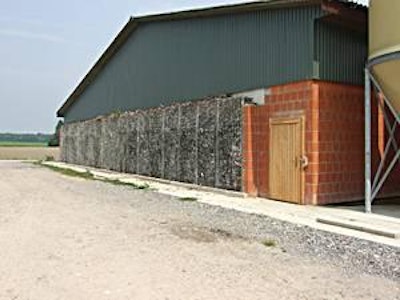
Controlling pig odors is becoming more important as swine units are getting bigger and are being built closer to urban populations. International pig researchers and equipment manufactures are focusing on developing the most effective air ventilation and emission control methods possible to combat foul manure odors and meet anti-air pollution regulations.
Cleaning the air
One option used by the University of Kentucky at its swine research facility just outside Lexington, Kentucky, is to place exhaust fans in vertical shafts and extend the chimneys up above ridge level, so that the foul air is forced high into the sky.
The MagixX air cleaning system, developed by Big Dutchman, is built into the end of the pig unit and extends across its full width. Exhaust air is pulled out of the pig area and passes through a filter bank, positioned at the end of the barn.
Water is sprayed on to the filter bank and the dust is then absorbed by water droplets and falls into the first water trough, according to a Big Dutchman spokesperson. Much of the ammonia is attached to the dust particles and so quite a large amount is taken out at this stage. The partially cleaned air then passes through a second filter bank, which has water containing sulphuric acid in it to trap any residual ammonia left in the air to produce ammonium sulphate, which accumulates in a second trough.
The air then passes through a filter of tree roots where a microbial transformation of odorous agents takes place. The system is cleaned every three months and the whole process is controlled electronically. All data such as the pH of the circulating water and power consumption can be transmitted via modem to a computer in the unit’s office or the farmer’s house.
Independent tests carried out by the University of Wageningen, Netherlands, found that the scrubbing system reduced fine dust by more than 90 percent and reduced ammonia concentration to trace amounts.
Various permutations of this pig odor system are possible. For example, just one filter bank with acid treatment may clean the air sufficiently. The one I saw was incorporated into a large barn, which took hogs from 6kg to 30kg and had a long passage giving access to 11 rooms, with pigs housed in groups of 24.
Ventilation technologies
In Denmark, the Danish Food and Research Council is currently conducting trials into air quality using pig finisher facilities at its Grønhøj experimental station. Researchers are looking at three different ventilation technologies for full-scale “at-source extraction.”
The aim is partly to prove that the technologies work under full-scale conditions and partly to analyze the pros and cons of the systems.
Last summer “at –source extraction” was investigated with two different levels of air output (7and 14m3/ pig) to document the optimum output. Preliminary results indicate that both these output levels result in equally good air quality, although the effects on emissions have not yet been analyzed.
With source extraction, the points of extraction are placed in areas of the house where contamination is highest. Extraction only covers a small part of the maximum extraction capacity of the ventilation system and the researchers discovered, for example, that a suction point placed under the pigs’ lying area was significantly more efficient than one placed under the dunging area.
Approved air cleaning technologies are on the Danish Environmental Protection Agency Technology list and several new technologies that may be able to reduce odors by up to 73 percent were added in 2011.
These new technologies include the SKOV BIO Module system, which was tested in a pig weaner facility and reduced ammonia emissions by 81 percent. The SKOV BIO Flex air cleaner with a new third filter section and modified controller was tested in a pig finisher barn. In trials, ammonia levels were reduced an average of 14.0ppm to 0.6ppm in the first two filter stages and odor concentration was reduced by 76 percent during the summer period. After the third filter step, the ammonia concentration was further reduced to 0.4ppm and the odor concentration was reduced by 80 percent in total.
The Dutch DORSET air cleaner, which is marketed by Rotor A/S, was on trial for a year. During this time the filter did not block and at no time was it necessary to wash the filter.
The Danish Pig Research Center is currently testing a chemical air cleaner (Munter A/S) on two pig finisher farms. What has been described as “promising data” has been collected from the first farm and the second farm is now under test. When all the data is collected it is hoped that this chemical air cleaner will also be included on the Danish Environmental Protection Agency Technology list.
While reducing odors and ammonia doesn’t come cheap, pig industry observers said they believe that if this investment allows the producer to stay in business, it is money well spent.
Ref: Danish Pig Research Center; Danish Agriculture and Food Council Annual Report 2011

















